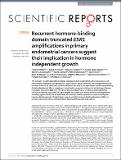Recurrent hormone-binding domain truncated ESR1 amplifications in primary endometrial cancers suggest their implication in hormone independent growth
Author(s)
Holst, Frederik; Hoivik, Erling A.; Taylor-Weiner, Amaro; Schumacher, Steven E.; Asmann, Yan W.; Grossmann, Patrick; Trovik, Jone; Necela, Brian M.; Thompson, E. Aubrey; Salvesen, Helga B.; Cherniack, Andrew D.; Gibson, William J; Beroukhim, Rameen; Meyerson, Matthew L.; ... Show more Show less
DownloadRecurrent hormone-binding.pdf (837.8Kb)
PUBLISHER_CC
Publisher with Creative Commons License
Creative Commons Attribution
Terms of use
Metadata
Show full item recordAbstract
The estrogen receptor alpha (ERα) is highly expressed in both endometrial and breast cancers, and represents the most prevalent therapeutic target in breast cancer. However, anti-estrogen therapy has not been shown to be effective in endometrial cancer. Recently it has been shown that hormone-binding domain alterations of ERα in breast cancer contribute to acquired resistance to anti-estrogen therapy. In analyses of genomic data from The Cancer Genome Atlas (TCGA), we observe that endometrial carcinomas manifest recurrent ESR1 gene amplifications that truncate the hormone-binding domain encoding region of ESR1 and are associated with reduced mRNA expression of exons encoding the hormone-binding domain. These findings support a role for hormone-binding alterations of ERα in primary endometrial cancer, with potentially important therapeutic implications.
Date issued
2016-05Department
Massachusetts Institute of Technology. Institute for Medical Engineering & Science; Broad Institute of MIT and Harvard; Harvard University--MIT Division of Health Sciences and TechnologyJournal
Scientific Reports
Publisher
Nature Publiashing Group
Citation
Holst, Frederik; Hoivik, Erling A.; Gibson, William J.; Taylor-Weiner, Amaro; Schumacher, Steven E. et al. “Recurrent Hormone-Binding Domain Truncated ESR1 Amplifications in Primary Endometrial Cancers Suggest Their Implication in Hormone Independent Growth.” Scientific Reports 6, 25521 (May 2016): 1-7 © 2016 Macmillan Publishers Limited, part of Springer Nature
Version: Final published version
ISSN
2045-2322